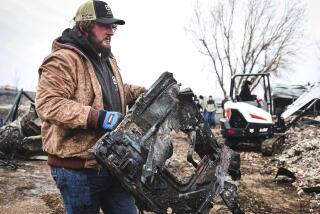Farmers Watch Weather Take Their Fields
- Share via
MONTE ALTO, Texas — The fields are so parched they’re catching fire. Cornfields are yellowing. Soil is turning to dust, casting a pall over highways. Coyotes and opossums are showing up around homes, looking for water from hoses and pets’ water dishes.
The second drought to hit Texas in three years is leaving farmers in dire straits and taxing the Lone Star State’s economy.
Texas is projecting agricultural losses of $517 million this year and an overall economic loss of $1.7 billion for the state. As of Friday, 33 counties had begun applying for a federal disaster declaration.
Animals are heading toward homes in search of something to drink. Opossums, which raid garbage cans and eat almost anything, have been spotted most often. Veterinarians at Oso Creek Animal Hospital in Corpus Christi recently saw a coyote near their doorstep.
In Big Bend National Park, mountain lions, which usually avoid people, have been less shy this year about human encounters, and park officials are warning visitors.
“We are telling them to be aware that there is a possibility that a cat can assault you anywhere, because right now they are hungry and stressed out from the lack of water,” ranger Mary Kay Manning said.
Hardly any part of the state is safe from drought following the combination of little rain in April and May and triple-digit temperatures earlier than expected. Louisiana is having similar problems but nothing like those of Texas.
“We really needed a good year,” said Charles Ray Krupala, who grows cotton and grain in South Texas’ Willacy County. “But it’s turning into the worst one yet.”
Texas has endured at least one drought every decade since the 1820s, including the Depression-era Dust Bowl and a seven-year uninterrupted drought in the 1950s.
The Rio Grande region hasn’t had any significant rainfall since early this year.
The Valley’s two reservoirs, Falcon Dam and Lake Amistad, are at one-quarter capacity, forcing several cities to ration water. Farther north, in the San Antonio area, water levels are dipping in the Edwards Aquifer, the area’s underground reservoir.
Big Bend National Park has had 1.8 inches of rain since January, well below the 5 inches it usually gets by June 30. And the Rio Grande is running as shallow as 2 feet.
Mary Jane Coder was hiking through the park with her family and had stopped to take a picture of her 8-year-old daughter, Dallas, when a mountain lion approached.
“She started screaming, ‘Mommy, get me down!’ as she reached out for me,” Coder told the Valley Morning Star of Harlingen. “I looked and saw a 100-pound mountain lion standing right behind her.”
Coder pushed the girl behind her, flicked open a pocketknife and advanced toward the cat.
“It started to back off, so I gathered the girls up and started to walk off,” Coder said. “But as I turned around, it rapidly reached out and slapped its paw down to puncture my hand right before it took off.”
More to Read
Sign up for Essential California
The most important California stories and recommendations in your inbox every morning.
You may occasionally receive promotional content from the Los Angeles Times.













